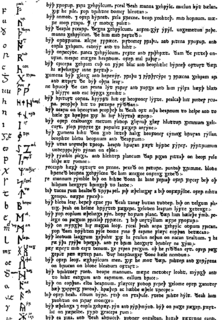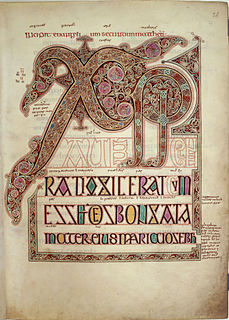Old English literature or Anglo-Saxon literature, encompasses literature written in Old English, in Anglo-Saxon England from the 7th century to the decades after the Norman Conquest of 1066. "Cædmon's Hymn", composed in the 7th century, according to Bede, is often considered the oldest extant poem in English, whereas the later poem, The Grave is one of the final poems written in Old English, and presents a transitional text between Old and Middle English. The Peterborough Chronicle can also be considered a late-period text, continuing into the 12th century.
Old English, or Anglo-Saxon, is the earliest historical form of the English language, spoken in England and southern and eastern Scotland in the early Middle Ages. It was brought to Great Britain by Anglo-Saxon settlers probably in the mid-5th century, and the first Old English literary works date from the mid-7th century. After the Norman conquest of 1066, English was replaced, for a time, as the language of the upper classes by Anglo-Norman, a relative of French. This is regarded as marking the end of the Old English era, as during this period the English language was heavily influenced by Anglo-Norman, developing into a phase known now as Middle English.

The Old English Bible translations are the partial translations of the Bible prepared in medieval England into the Old English language. The translations are from Latin texts, not the original languages.

A herbal is a book containing the names and descriptions of plants, usually with information on their medicinal, tonic, culinary, toxic, hallucinatory, aromatic, or magical powers, and the legends associated with them. A herbal may also classify the plants it describes, may give recipes for herbal extracts, tinctures, or potions, and sometimes include mineral and animal medicaments in addition to those obtained from plants. Herbals were often illustrated to assist plant identification.
Northumbrian was a dialect of Old English spoken in the Anglian Kingdom of Northumbria. Together with Mercian, Kentish and West Saxon, it forms one of the sub-categories of Old English devised and employed by modern scholars.
Mercian was a dialect spoken in the Anglo-Saxon kingdom of Mercia. Together with Northumbrian, it was one of the two Anglian dialects. The other two dialects of Old English were Kentish and West Saxon. Each of those dialects was associated with an independent kingdom on the island. Of these, all of Northumbria and most of Mercia were overrun by the Vikings during the 9th century. Part of Mercia and all of Kent were successfully defended but were then integrated into the Kingdom of Wessex. Because of the centralisation of power and the Viking invasions, there is little to no salvaged written evidence for the development of non-Wessex dialects after Alfred the Great's unification, until the Middle English period.

The Vespasian Psalter is an Anglo-Saxon illuminated psalter decorated in a partly Insular style produced in the second or third quarter of the 8th century. It contains an interlinear gloss in Old English which is the oldest extant English translation of any portion of the Bible. It was produced in southern England, perhaps in St. Augustine's Abbey or Christ Church, Canterbury or Minster-in-Thanet, and is the earliest illuminated manuscript produced in "Southumbria" to survive.
The Lacnunga ('Remedies') is a collection of miscellaneous Anglo-Saxon medical texts and prayers, written mainly in Old English and Latin. The title Lacnunga, an Old English word meaning 'remedies', is not in the manuscript: it was given to the collection by its first editor, Oswald Cockayne, in the nineteenth century. It is found, following other medical texts, in London, British Library Manuscript Harley 585, a codex probably compiled in England in the late tenth or early eleventh century. Many of its herbal remedies are also found, in variant form, in Bald's Leechbook, another Anglo-Saxon medical compendium.
"Wið færstice" is an Old English medical text surviving in the collection known now as Lacnunga in the British Library. "Wið færstice" means 'against a sudden/violent stabbing pain'; and according to Felix Grendon, whose collection of Anglo-Saxon charms appeared in the Journal of American Folklore in 1908, “the charm is intended to cure a sudden twinge or stitch, possibly rheumatism that can be due to being shot by witches, elves, and other spirits that fly through the air.” Scholars have often sought to identify this as rheumatism, but other possibilities should not be excluded. The remedy describes how to make a salve, but its main interest lies in the unique charm which follows. This describes how the færstice has been caused by the projectiles of 'mighty women', whom the healer will combat. The charm also mentions elves, believed responsible for elfshot, and provides the only attestation outside personal names of the Old English form of the name of the Old Norse gods, the Æsir.

Sempervivum tectorum is a species of flowering plant in the family Crassulaceae, native to the mountains of southern Europe, cultivated in the whole of Europe for its appearance and a Roman tradition claiming that it protects buildings against lightning strikes.

The Anglo-Saxon Chronicle is a collection of annals in Old English chronicling the history of the Anglo-Saxons. The original manuscript of the Chronicle was created late in the 9th century, probably in Wessex, during the reign of Alfred the Great. Multiple copies were made of that one original and then distributed to monasteries across England, where they were independently updated. In one case, the Chronicle was still being actively updated in 1154.
Cædmon's "Hymn" is a short Old English poem originally composed by Cædmon, an illiterate cow-herder who was able to sing in honour of God the Creator, using words that he had never heard before. It was composed between 658 and 680 and is the oldest recorded Old English poem, being composed within living memory of the Christianization of Anglo-Saxon England. It is also one of the oldest surviving samples of Germanic alliterative verse.

The Old English rune poem, dated to the 8th or 9th century, has stanzas on 29 Anglo-Saxon runes. It stands alongside younger rune poems from Scandinavia, which record the names of the 16 Younger Futhark runes.
Cotton Cleopatra A.iii is an Anglo-Saxon manuscript once held in the Cotton library, now held in the British Library, and contains three glossaries, providing important evidence for Old English vocabulary, as well as for learning and scholarship in Anglo-Saxon England generally. The manuscript was probably written at St Augustine's, Canterbury, and has generally been dated to the mid-tenth century, though recent work suggests the 930s specifically. The manuscript contains three Latin-Old English glossaries.
The Leiden Glossary is a glossary contained in a manuscript in Leiden University Library, Voss. Lat. Q. 69. The lemmata (headwords) come from "a range of biblical, grammatical, and patristic texts". It is based on an Anglo-Saxon exemplar, and was prepared c. 800 in the Abbey of Saint Gall in modern-day Switzerland.
The Royal Prayer Book is a collection of prayers believed to have been copied in the late eighth century or the early ninth century. It was written in West Mercia, likely either in or around Worcester.
The Épinal-Erfurt glossary is a glossary of terms. It consists of two manuscripts, and contains terms in Old English.
The Corpus Glossary is one of many Anglo-Saxon glossaries. Alongside many entries which gloss Latin words with simpler Latin words or explanations, it also includes numerous Old English glossaries on Latin words, making it one of the oldest extant texts in the English language.
The Harley Glossary is an Anglo-Saxon glossary, mostly providing glosses on Latin words. It mostly survives in the fragmentary British Library, MS Harley 3376, but fragments are also found in Lawrence, University of Kansas, Kenneth Spenser Research Library, Pryce P2 A: 1, and Oxford, Bodleian Library, Lat. Misc. a. 3., fol. 49. The manuscript was produced in western England in the eleventh century, and has been argued to have been produced at Worcester Cathedral.






